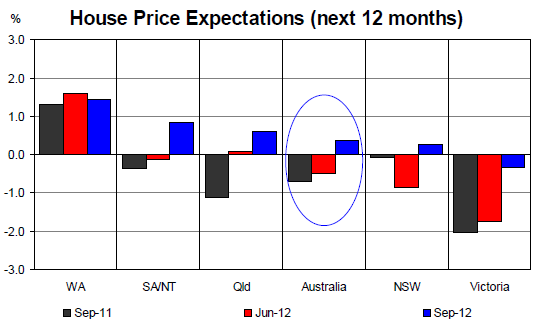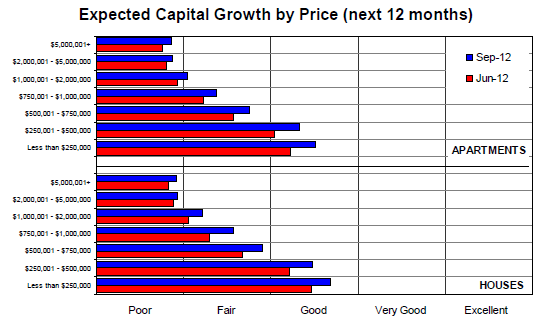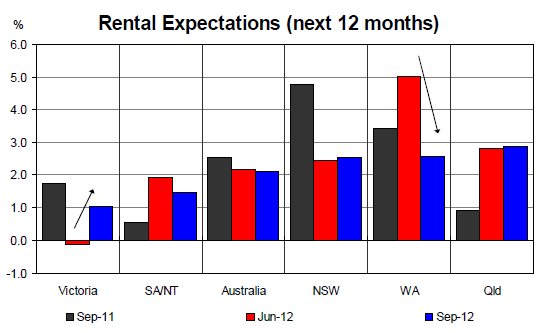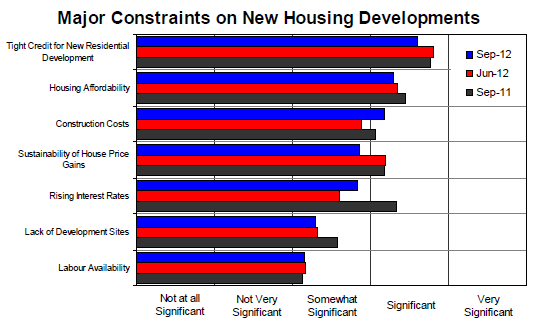NAB released the September edition of its Residential Property Survey today, which canvasses property insiders, and it showed an unsurprising bounce in the index:

However, the translation of this rise into price expectations remains quite subdued:

Here is what NAB reckons:
- NAB Residential Property Index turns positive in Q3’12 as property professionals see downward correction in national house prices slowing. Market expected to recover in the next year, with prices rising 0.4% nationally. Prices to rise in all states except Victoria.
- NAB Residential Property Index turns positive in Q3’12 as property professionals see downward correction in national house prices slowing. Market expected to recover in the next year, with prices rising 0.4% nationally. Prices to rise in all states except Victoria.
- NAB’s Residential Property Index rose to +4 points in Q3’12 (-8 points in Q2’12). WA the strongest state, but Queensland improving rapidly. State index also turns positive in NSW, but still negative in SA/NT and Victoria. Queensland and SA/NT to be the strongest states in next 2 years. Victoria the weakest but gaining ground.
- National house prices fell -0.7% in Q3’12 (-1.6% in Q2’12). All states bar WA (0.1%) reported negative growth but the rate of decline slowed in all states. Victoria still the weakest market (-1.1%). Prices also down in Queensland (-0.8%), NSW (-0.6%) and SA/NT (-0.3%). National house prices expected to grow 0.4% over next year and 1.7% over next 2 years. WA joined by Queensland and SA/NT as most optimistic states for price growth in next 2 years. Victoria still the weakest state, but prices to resume growing modestly.
- National rents rise 0.2% in Q3’12 but state performance varies. Victoria (-0.5%) softest market with Melbourne having highest vacancy rates among capitals. Rents also down in SA/NT (-0.4%), but up in NSW (0.2%), Queensland (0.6%) and WA (1.1%) where influx of transient workers is keeping vacancies low. Property professionals see rents growing 2.1% in next year and 3.4% in next 2 years with rents growing in all states.
- Overseas buyers emerging as important players in the market for new developments. Demand for new property strongest for inner city low rise apartments and townhouses and inner city houses but only assessed as “fair”.
- Tight credit and housing affordability still seen as the main obstacles to new building, but concern also rising over construction costs.
- Lower interest rates and rental growth are boosting local investor demand in the existing property market.
- Overall demand for existing property is strongest in the inner city and capital growth prospects best in the sub- $500,000 range. Buying activity is much more cautious in the prestige market, with capital growth expectations for that sector considered to be “poor” in both the housing and apartment markets in all state markets.
- Employment security has become entrenched as the biggest impediment to purchasing existing property according to our survey panel, especially in Victoria and Queensland. Access to credit also identified as a “significant” impediment to purchasing existing property.
I’ll only add that these type of sentiment surveys tend to follow not lead price gains.
More interesting are some of the sub-components. They confirm that the lower end of the market is where all the action is:

And that rental expectations are already getting hit in WA, QLD is yet to wake up:

For new property, the role of foreign buyers is increasingly important:

But credit is tight:

I suspect this is because banks will not lend on new developments while sale prices are above market values. Even with a big deposit, punters would have a negative LVR. And if your deposit is that big then why go to the sticks?
This is a big problem for the RBA’s new construction agenda and can only be solved by pretty decent across the market price rises.
Hang onto your hats!

